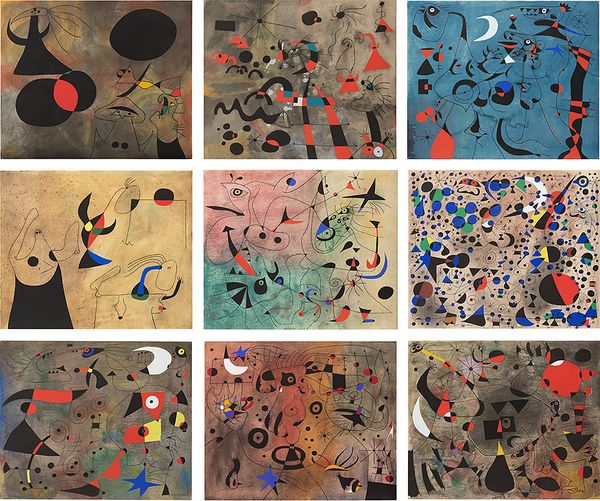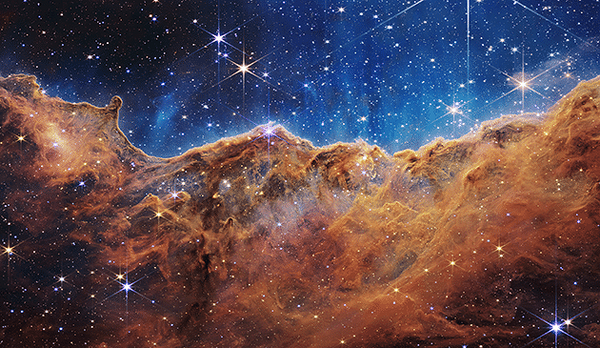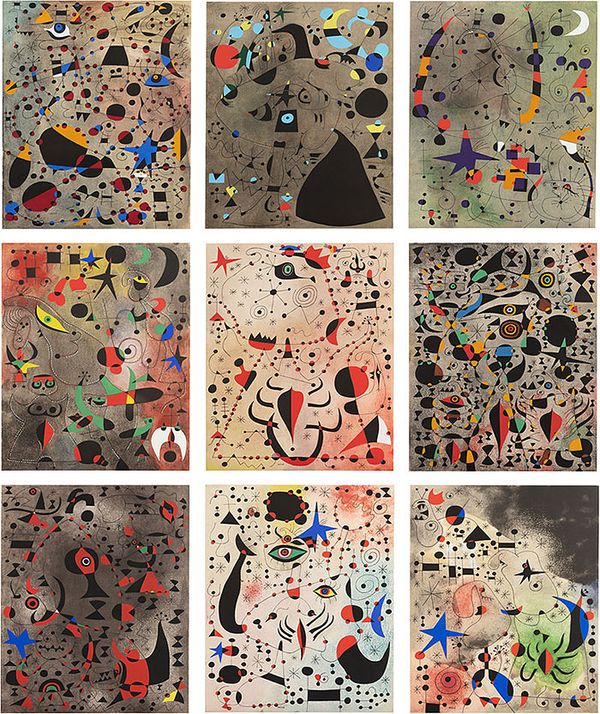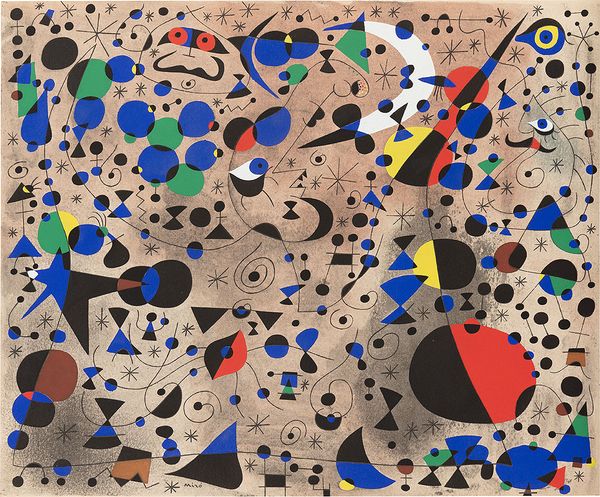Joan Miró, Constellations (M. 260, C. bks 58), 1959. Editions & Works on Paper.
Beginning in January 1940 and continuing over a period of 20 months, Joan Miró created a series of 23 oil and gouache paintings on paper, each measuring 15 x 18 inches containing related imagery of cosmic order — planets, suns, stars, crescent moons, birds, lovers — shining nocturnal jewels that became known as his 'Constellation' series. After the original exhibition of the paintings at Pierre Matisse’s gallery in early 1945, the individual gouaches of the Constellations were all sold, widely dispersed and not reunited until 1959, when Pierre Matisse, with Miró’s full support, decided to publish an elaborate facsimile with stenciling edition. The resulting prints are of such high quality that, excluding their slight difference in size from the originals, they are virtually indistinguishable from their models. This set on offer in Phillips' 24 - 26 October Editions & Works on Paper Auction in New York includes one lithograph in colors and 18 pochoir reproductions in colors after gouaches by the artist.
Written by Ravit Helled
“Where do we come from?”
“How big is the Universe and what is its fate?”
“How do stars and planets form?"
“Are we alone?”
Asked by astrophysicists and artists alike, these questions have kept humanity busy for a very long time. Even our ancestors tried to make sense of the night sky, connecting stars to create the constellations. Joan Miró’s 1959 Constellations reflect this attempt to create order from chaos and to give meaning to shapes and colors. Today, our understanding of the universe in all its different scales continues to improve thanks to new observations — yet many are so technical that they are interpreted and understood only by a small community of scientists. Despite their importance, often such exciting measurements don’t reach the attention of the general public. But there is another type of measurement that does impact nearly all of us: remarkable, overwhelming images of the universe captured by the recently launched James Webb Space Telescope (JWST).

Joan Miró, Constellations (M. 260, C. bks 58), 1959. Editions & Works on Paper.
While the effort of understanding the universe using advanced technology goes back several decades, a new era in the visualization of the beauty of astronomical objects began in 1990 with the launch of the Hubble Space Telescope (HST). (Interestingly, this telescope was named for Edwin Hubble in 1983, the same year Miró died.) This huge space-based observatory has revolutionized the field of astronomy. During its operation, spanning three decades and still ongoing today, Hubble has performed more than 1.5 million observations. But the HST not only influenced astronomy, it also impacted the imagination and curiosity of humanity. I still remember how the first astonishing images took my breath away. Their depth and complexity have encouraged me to discover the mysteries of space ever since. With Hubble, we could suddenly look into the universe from a different perspective, making space more reachable, or at least, something that is less surreal, and can be translated into structures and colors.

Thousands of galaxies are visible in this image from the James Webb Space Telescope, seen in various stages of galactic evolution that span 13.2 billion years of galaxy development, scattered across a black backdrop of space. Courtesy NASA/JPL-Caltech.
In December 2021, we entered a new phase in space exploration with the launch of the James Webb Space Telescope. The JWST, also known as Webb, “sees” in near-infrared and mid-infrared wavelengths, corresponding to light beyond the red end of the visible spectrum. The human eye perceives radiation at this wavelength as heat. Yet Webb's view in infrared allows us to detect cold objects that don’t emit much energy or objects that are not visible in other wavelengths. Its design also allows us to observe “dusty” environments, such as regions where stars and planets form. Observing at this wavelength reveals new details in images, providing a chance to explore many mysteries, including the early evolution of the universe and the formation of the first stars and galaxies.
The initial data from JWST is freely available for all to look at and interpret. The first images arrived in July 2022, and again, we witnessed that reality goes way beyond imagination. These stunning images are much like abstract artworks. The first published JWST images, which only provide a glimpse toward its capability of exploring the universe, include various astrophysical objects covering large ranges of space and time: old galaxies, young nebulae, regions where star and planet formation takes place, the outer planets of the Solar system, and even observations of the atmospheric composition of gaseous planets orbiting other stars. Fascinatingly, Miró interpreted our earlier understanding in the 1950s of these dusty and gaseous, colorful regions of deep space through highly elaborate washes. When making his original Constellation paintings, he purposely worked the surface of the paper to produce texture, sometimes a bit grainy. I can only imagine the incredible creations Miró might have made if he had seen the images from our space telescopes.

Joan Miró, Constellations (M. 260, C. bks 58), 1959. Editions & Works on Paper.
The scientific discoveries associated with JWST have only just begun. Since Webb's expected lifetime is several decades, and based on our past experience with astronomical observations, we can't even predict the impact it will have on science and human knowledge. Surprises are yet to come! I, for one, look forward to the upcoming observations, new theories, and future challenges for science. Beyond its scientific contribution, Webb, like other large space telescopes, is expected to affect humanity. In addition to stimulating our imagination, it teaches us to be modest. After all, we are only a negligible piece of the cosmos, and lucky to be here for several decades, during a special time when we can take a deeper look into the universe and learn about our origins.
Ravit Helled is a Professor of Theoretical Astrophysics at the Institute for Computational Science, Center for Theoretical Astrophysics & Cosmology, University of Zurich. Helled’s scientific work concentrates on planet formation and evolution, planetary interiors, and extrasolar planets. She is an international expert in planetary modeling, and uniquely addressing the link between planetary formation, evolution, and internal structure, as well as linking exoplanetary studies with solar system science. Professor Helled is strongly involved in space exploration and is a key member in several ESA and NASA space missions.
Discover More from Editions & Works on Paper >
Recommended Reading
Joan Miró: Prints to Rival Any Painting >
